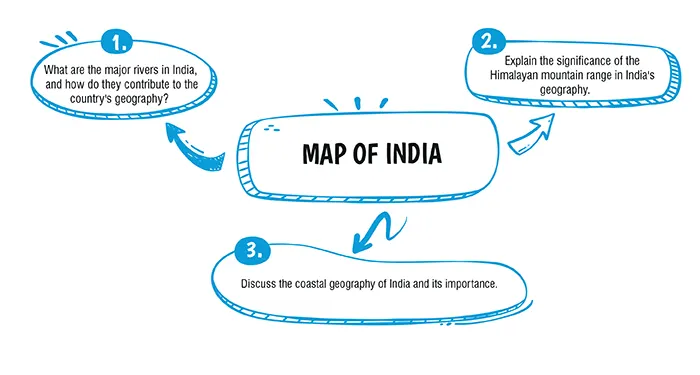Table of Contents

Ans.(a)
Explanation:
Jammu and Kashmir is the northernmost state in India
Ans.(b)
Explanation:
Kerala is the The Indian state marked by the capital city of Thiruvananthapuram
Explanation:
India is home to several major rivers, including the Ganges, Yamuna, Brahmaputra, Indus, and Godavari. These rivers play a crucial role in the country's geography, providing fertile plains for agriculture and supporting diverse ecosystems. The Ganges, in particular, is considered sacred in Hinduism and has a significant cultural and religious importance.
Explanation:
The Himalayas, the world's highest mountain range, serve as India's northern border. They play a crucial role in shaping the climate, acting as a barrier to cold winds from Central Asia. The rivers originating in the Himalayas, such as the Ganges and Brahmaputra, are a major source of water for the plains below. Additionally, the Himalayas are culturally significant, influencing art, mythology, and religious practices.
Explanation:
India has a vast coastline along the Arabian Sea to the west, the Bay of Bengal to the east, and the Indian Ocean to the south. The coastal regions are economically significant, with thriving industries, ports, and fisheries. The Western Ghats and Eastern Ghats influence the coastal climate, contributing to the biodiversity of these regions. The coastal areas also play a crucial role in trade and cultural exchange.
Download Mind Map of this chapter
Download NowWant to Practice Mock Tests of this chapter
Practice NowDownload Important Questions of this chapter
Download Now| Chapter No. | Chapter Name |
|---|---|
| Chapter 1 | Map Study: Interpretation of Topographical Maps |
| Chapter 2 | Map of India |
| Chapter 3 | Location, Extent and Physical features |
| Chapter 4 | Climate of India |
| Chapter 5 | Soil Resources |
| Chapter 6 | Natural Vegetation of India |
| Chapter 7 | Water Resources |
| Chapter 8 | Mineral and Energy Resources |
| Chapter 9 | Agriculture In India |
| Chapter 10 | Industries in India: Agro Based |
| Chapter 11 | Industries in India: Mineral Based |
| Chapter 12 | Transport in India |
| Chapter 13 | Waste Generation and Management |
CBSE Important Questions Class 10
ICSE Important Questions Class 10
CBSE Important Questions Class 10
ICSE Important Questions Class 10